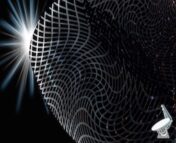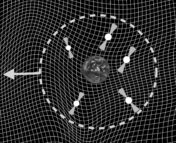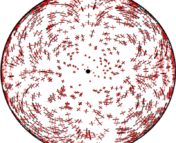Authors: Lucas M. B. Alves, Andrew G. Sullivan, Imre Bartos, Doğa Veske, Sebastian Will, Zsuzsa Márka, Szabolcs Márka
First Author’s Institution: Department of Physics, Columbia University in the City of New York, New York, NY 10027, USA
Status: Currently only pre-print available
Since the first direct detection in 2015, gravitational wave (GW) astronomy is now making its first exciting forays in different frequency bands. Much like electromagnetic light, where you have observatories from the low radio frequencies through to high frequency X-ray and gamma ray telescopes, GW observatories can span different ranges of GW frequencies, and thus have to be constructed in different ways. These different ranges allow us to detect different astrophysical sources, and learn different things about the dynamic universe.
We’ve already started tuning into multi-band GW detection with ground based interferometry of LIGO–Virgo–KAGRA (LVK) and the collaborations of the International Pulsar Timing Array (IPTA) both making detections of GWs. Last week’s approval of the Laser Interferometer Space Antenna (LISA) means certainty is set for millihertz gravitational wave detection, with frequencies which lie in between the LVK ranges of 10-1000 Hz and the IPTA nanohertz bands, as is shown in Figure 1. However, a gap remains for GWs in between 0.1-10 Hz. Proposed to probe this band is the Deci-hertz Interferometer Gravitational Wave Observatory (DECIGO) space mission, planned to launch in the 2030s. For interferometry detection of GWs, longer laser arms means you can detect longer wavelengths of GWs and hence lower frequency bands. DECIGO is essentially a mini version of LISA, a triangular interferometer made up of 3 spacecraft, only DECIGO’s spacecraft will be separated by 1000 kilometres, compared to LISA’s of 2.5 million kilometres.
Today’s paper presents an alternative option to detect deci-hertz GWs, using a timing array like the PTAs instead of laser interferometry. Pulsar timing arrays work by measuring the ‘ticks’ from very accurate clocks – in the case of nanohertz GWs these clocks are millisecond pulsars spinning hundreds of times a second. There can be deviations of these ticks from their expected times of arrival due to a GW stretching or squeezing spacetime, delaying or speeding up the ticks. For this alternative detector, instead of using pulsars spread across the galaxy as the clocks, the authors propose sticking closer to home with a group of atomic clock satellites orbiting the Earth or a separate receiver, making up an Artificial Precision Timing Array (APTA).
Two things need to be considered when dreaming up a new GW detector – how to detect GWs at a certain frequency range, and how to achieve the required detector sensitivity and reduce any sources of noise in that range. The frequency of GWs that PTAs are sensitive to is governed by the total length of observation time, and how often observations of the clocks occur. For PTAs, the low frequencies require pulsars to be observed over long periods of time to maximise the number of GW wavelengths that sweep past the pulsar clocks, but it’s okay if telescopes can only point to the pulsars to collect ticks every few weeks. Today’s authors state that by taking data from the clock satellites every 0.1s and looking for signals that last at least 10 seconds, they can probe the 0.1-10 Hz range. As long as the atomic clocks are always pointing at a receiver, this idea is purposefully designed not to be limited by competing for telescope observations.
The next step is to ensure high sensitivity to these GWs, which requires extremely accurate atomic clocks. Current atomic clocks deviate by as little as 1 part in 1017 over a 1 second interval, which means that we could use these in the proposed APTA to detect the strongest deci-hertz GWs, as shown in Figure 2. More signals could be detected with even more accurate clocks with errors as low as 1 part in 1019 which is thought to be a reasonable target for atomic clocks within the next decade. The authors also demonstrate that remarkably accurate clocks with 1 part in 1022 timing errors would be sensitive enough to detect primordial black hole binaries.
While the sources of gravitational waves vary, so far we mostly have detected merging black holes and neutron stars. For these mergers, the frequency of the gravitational waves at time of merging is determined by the amount of mass in the system. Lower frequencies means the source must be lower in mass, or the objects merging are detected earlier in their spiral into each other. This means that as objects spiral closer to each other, their emitted GWs will move through multiple frequency bands, and we could even make predictions about when and where a binary is going to merge before it does. Having sensitive GW detectors covering all frequency bands allows us to follow black holes and neutron stars along their evolution, and potentially allow astronomers to know the location of a potential kilonovae before they shine in electromagnetic light when two neutron stars merge. In addition, an APTA configuration would also be sensitive to intermediate mass black hole binaries, which are 10-1000 times heavier than the black holes currently detected with LVK detectors, and of which little is known. All of these gravitational wave sources sing together out in the universe, from bass to soprano, and only with multiple detectors will we be able to listen to them all.
While there’s still a number of technical details required to build a highly sensitive APTA that aren’t detailed in this paper, this idea illustrates the capabilities of having different kinds of GW observatories. Adding to the set of GW observatories across distinct frequency bands, both of the interferometer variety and the timing array variety, will not only mean technological advances in building extremely sensitive instruments, but also let us tune into different melodies in the GW symphony.
Astrobite edited by Sonja Panjkov
Featured image credit: Figure 1 in today’s paper




